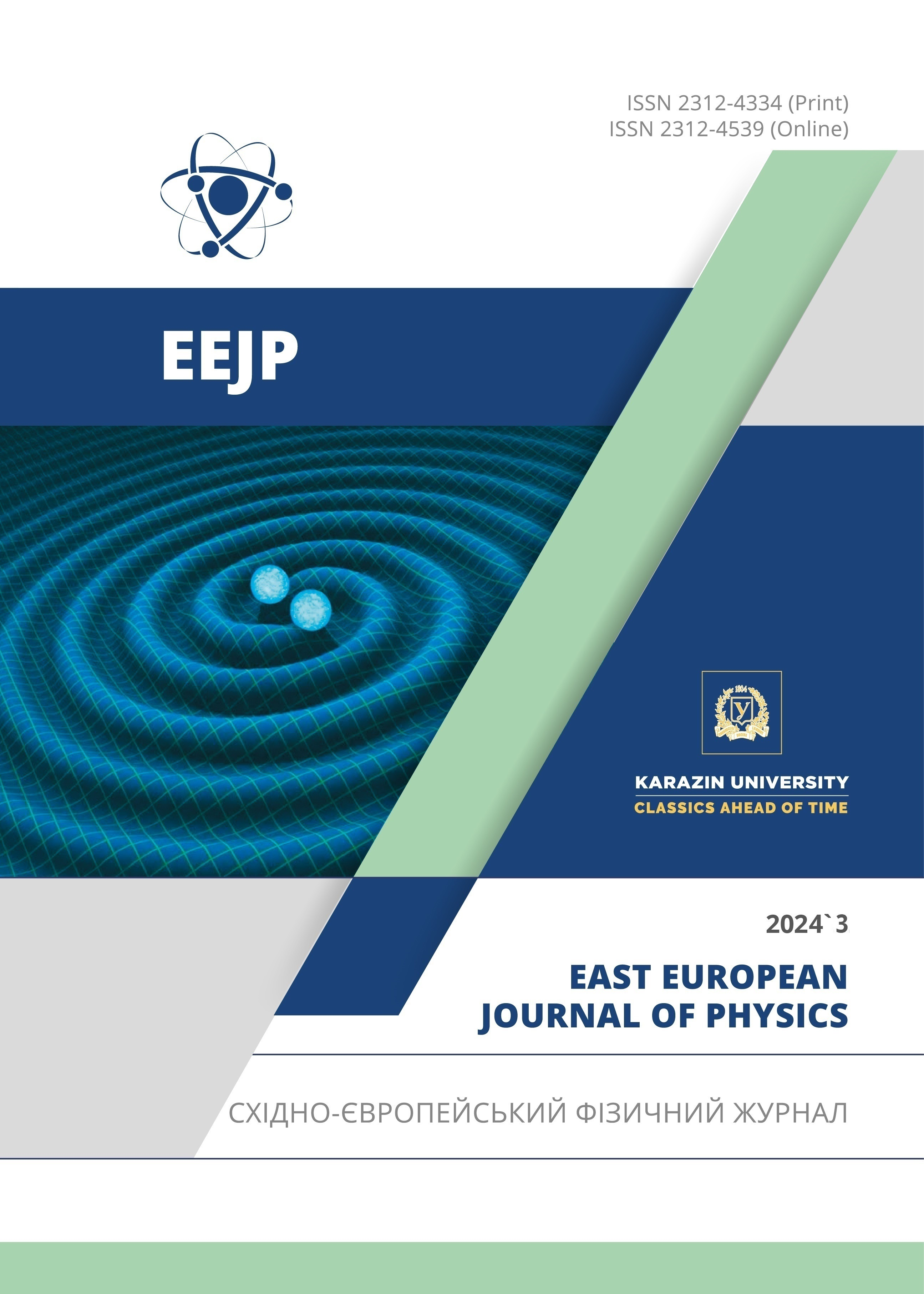Спектральні та часові дослiдження V404 Cygni за допомогою CHANDRA спостережень
Анотація
Ми представляємо спектральне та часове дослiдження V404 Cygni з усiх доступних спостережень Chandra, якi нещодавно опублiкованi в архiвi даних Chandra. Обробку та аналiз даних проводили за допомогою CIAO 4.14 i HEASOFT 6.30.1. Спектральний аналiз проводився за допомогою пакета спектрального пiдбору XSPEC версiї 12.12.1, доступного в пакетi Heasoft. Спектр джерела встановлюється в дiапазонi енергiй 0,3-8,0 кеВ з використанням двох емпiричних спектральних моделей поглиненого степеневого закону та поглиненого диска-чорного тiла. Встановлено, що подвiйне джерело рентгенiвського випромiнювання V404 Cygni знаходиться в станi спокою, його рентгенiвська свiтнiсть у кiлька разiв перевищує 1032 ерг с−1. Виявлено, що джерело перебуває у жорсткому станi та добре пояснюється степеневою моделлю зi степеневим iндексом фотона Γ ∼ 2 з nH у дiапазонi ∼ (0,7 -1,2 ) × 1022 cm−2. Згiдно з аналiзом часу, Src-1 (V404 Cygni), у всiх iнтервалах часу - 0,5, 1 i 2 кс, ймовiрнiсть того, що швидкiсть рахунку буде постiйною, становить 0,17 ×10−33 у всiх спостереженнях у 2021 та 2023 роках
(ObsID 23421, ObsID 23422, ObsID 23423 & ObsID 28927). Однак у спостереженнях за 2017 рiк вiн виявився менш мiнливим. Це чiтко демонструє наявнiсть короткочасної мiнливостi в кiлосекундних масштабах часу з доступними на даний момент даними Chandra. Отже, показово, що бiнарне джерело V404 Cygni, швидше за все, буде змiнним джерелом як у довгостроковому (роки), так i в короткостроковому (кiлосекунди) масштабах.
Завантаження
Посилання
J.E. McClintock, and R.A. Remillard, Compact Stellar X-ray Sources, edited by W.H.G. Lewin, and M. van der Klis, (Cambridge University Press, 2006).
J.K. Cannizzo, Astrophysical Journal, 419, 318 (1993).
J.P. Lasota, New Astron Review, 45, 449 (2001). https://doi.org/10.1016/S1387-6473(01)00112-9
T.M. Belloni, and S.E. Motta, in: Astrophysics of Black Holes: From Fundamental Aspects to Latest Developments, edited
by C. Bambi, Astrophys. Space Sci. Libr. 440, (Springer, Berlin, Heidelberg, 2016). pp. 61-67. https://doi.org/10.1007/978-3-662-52859-4 2
H. Tananbaum, H. Gursky, E. Kellogg, R. Giacconi, and C. Jones, ApJ, 177, L5 (1972). https://doi.org/10.1086/181042
R.A. Remillard, and J.E. McClintock, Ann. Rev. A & A, 44, 49 (2006). https://doi.org/10.1146/annurev.astro.44.051905.092532
T.M. Belloni, and L. Stella, Space Science Review, 183, 43 (2014). https://doi.org/10.1007/s11214-014-0076-0
A.R. Ingram, and S.E. Motta, New Astron. Rev. 85, 101524 (2019). https://doi.org/10.1016/j.newar.2020.101524
F. Makino, IAUC, 4782, 1 (1989).
J.C.A. Miller-Jones, P.G. Jonker, V. Dhawan, W. Brisken, M.P. Rupen, G. Nelemans, and E. Gallo, ApJ, 706, L230 (2009). https://doi.org/10.1088/0004-637X/706/2/L230
A. Jana, J.-R. Shang, D. Debnath, S.K. Chakrabarti, D. Chatterjee, and H.-K. Chang, Galaxies, 9, 39 (2021). https://doi.org/10.3390/galaxies9020039
Y. Tanaka, in: Proc. 23rd ESLAB Symp. On Two-Topics in X-ray Astronomy, ESA SP-296, 1, edited by J. Hunt, and B. Battrick, (ESA, Paris, 1989).
J. Rodriguez, M.Cadolle Bel, J. Alfonso-Garz´on, et al., A & A, 581, L9 (2015). https://doi.org/10.1051/0004-6361/201527043
J.P. Roques, E. Jourdain, A. Bazzano, et al., ApJ, 813, L22 (2015). https://doi.org/10.1088/2041-8205/813/1/L22
P.A. Jenke, C.A. Wilson-Hodge, H. Jeroen, et al., ApJ, 826 37 (2016). https://doi.org/10.3847/0004-637X/826/1/37
T. Munoz-Darias, J. Casares, M.D. S´anchez, et al., MNRAS: Letters, 465, L124 (2017). https://doi.org/10.1093/mnrasl/slw222
J.J.E. Kajava, S.E. Motta, et al., A & A, 616, A129 (2018). https://doi.org/10.1051/0004-6361/201731768
J. Khargharia, C.S. Froning, and E.L. Robinson, ApJ, 716, 1105 (2010). https://doi.org/10.1088/0004-637X/716/2/1105
A.S. Devi, R. Misra, V.K. Agrawal, and K.Y. Singh, ApJ, 664, 458 (2007). https://doi.org/10.1086/518533
R.M. Wagner, S.G. Starrfield, R.M. Hjellming, S.B. Howell, and T.J. Kreidl, ApJL, 429, L25 ( 1994). https://doi.org/10.1086/187404
R. Narayan, D. Barret, and J.E. McClintock, ApJ, 482, 448 (1997). https://doi.org/10.1086/304134
A.K.H. Kong, J.E. McClintock, M.R. Garcia, S.S. Murray, and D. Barret, ApJ, 570, 277 (2002). https://doi.org/10.1086/339501
C.K. Bradley, R.I. Hynes, A.K.H. Kong, et al., ApJ, 667, 427 (2007). https://doi.org/10.1086/520323
M.T. Reynolds, R.C. Reis, J.M. Miller, E.M. Cackett, and N. Degenaar, MNRAS, 441, 3656 (2014). https://doi.org/10.1093/mnras/stu832
J. Mart´ı, P.L. Luque-Escamilla, and M.T. Garc´ıa-Hern´andez, A& A, 586, A58 (2016). https://doi.org/10.1051/0004-6361/201527239
V. Rana, A. Loh, S. Corbel, et al., ApJ, 821, 103 (2016). https://doi.org/10.3847/0004-637X/821/2/103
Авторське право (c) 2024 С. Рiта Девi, А. Сеньорита Девi, Атрi Дешамукхья

Цю роботу ліцензовано за Міжнародня ліцензія Creative Commons Attribution 4.0.
Автори, які публікуються у цьому журналі, погоджуються з наступними умовами:
- Автори залишають за собою право на авторство своєї роботи та передають журналу право першої публікації цієї роботи на умовах ліцензії Creative Commons Attribution License, котра дозволяє іншим особам вільно розповсюджувати опубліковану роботу з обов'язковим посиланням на авторів оригінальної роботи та першу публікацію роботи у цьому журналі.
- Автори мають право укладати самостійні додаткові угоди щодо неексклюзивного розповсюдження роботи у тому вигляді, в якому вона була опублікована цим журналом (наприклад, розміщувати роботу в електронному сховищі установи або публікувати у складі монографії), за умови збереження посилання на першу публікацію роботи у цьому журналі.
- Політика журналу дозволяє і заохочує розміщення авторами в мережі Інтернет (наприклад, у сховищах установ або на особистих веб-сайтах) рукопису роботи, як до подання цього рукопису до редакції, так і під час його редакційного опрацювання, оскільки це сприяє виникненню продуктивної наукової дискусії та позитивно позначається на оперативності та динаміці цитування опублікованої роботи (див. The Effect of Open Access).








